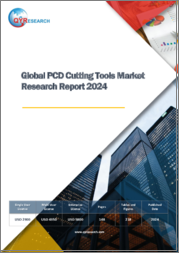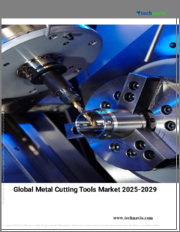
|
시장보고서
상품코드
1541197
세계의 고속도강 절삭 공구 시장 보고서 : 유형, 기술, 최종 이용 산업, 지역별(2024-2032년)High Speed Steel Cutting Tools Market Report by Type, Technology (Conventional, CNC ), End Use Industry, and Region 2024-2032 |
||||||
세계의 고속도강 절삭 공구 시장 규모는 2023년 89억 달러에 달했습니다. 향후 IMARC Group은 시장이 2032년까지 121억 달러에 이르고, 2024년과 2032년 사이에 3.4%의 성장률(CAGR)을 나타낼 것으로 예측했습니다.
고속도강(HSS) 절삭 공구는 밀링, 태핑, 드릴 가공, 절단 가공, 성형 가공, 연삭 가공, 볼링 가공, 강재 주조 등에 사용되는 다양한 기계 장치를 말합니다. 일반적으로 사용되는 하이스 절삭 공구로는 드릴 비트, 솔리드 볼링 바, 체이저, 카운터 보어, 카운터 싱크, 추출기, 널링, 톱날, 탭, 엔드밀 등이 있습니다. 기존에 비해 고속도강 절삭 공구는 입자 야금을 사용하여 설계가 개선되고 높은 절삭 속도로 작동하며 극한 온도에서도 작동하며 부식과 마모에 강합니다. 그 결과 석유 및 가스, 자동차, 해양, 항공우주, 방위, 에너지 및 전력 등 다양한 산업에서 폭넓게 사용되고 있습니다.
세계 제조업의 현저한 성장은 시장에 긍정적인 영향을 미치는 중요한 요소 중 하나입니다. HSS 절삭 공구는 대량 생산 및 고온 작업에서 제품의 품질을 균일하게 만드는 데 매우 중요합니다. 또한 자동차 산업에서 이러한 공구가 널리 채용되고 있는 것도 시장 성장의 원동력이 되고 있습니다. 고정밀도, 내구성, 재현성으로 다양한 자동차 부품의 밀링, 연삭 가공, 브로치 가공에 사용됩니다. 게다가 공구용의 새로운 코팅 기술의 개척이나 조성을 조정할 수 있는 비트의 제조 등 다양한 제품 혁신도 시장 성장에 기여하고 있습니다. 또한 시장 기업은 절삭 공구를 IoT(사물 인터넷)와 통합하여 진동을 최소화하고 정확도를 높이고 가속화된 공구를 제공합니다. 금속가공산업에 대한 투자 증가와 Industry 4.0 등장 등 기타 요인들도 시장을 더욱 견인할 것으로 예측됩니다.
이 보고서에서 다루는 주요 질문
- 세계의 고속도강 절삭 공구 시장은 지금까지 어떻게 추이하고 향후 어떻게 추이할 것인가?
- COVID-19는 세계의 고속도강 절삭 공구 시장에 어떤 영향을 미쳤는가?
- 주요 지역 시장은?
- 유형별 시장 분석은?
- 기술별 시장 분석은?
- 최종 이용 산업별 시장 분석은?
- 업계의 밸류체인의 다양한 단계란?
- 업계의 주요 촉진요인과 도전은 무엇인가?
- 세계의 고속도강 절삭 공구 시장의 구조와 주요 기업은?
- 업계 경쟁도는?
목차
제1장 서문
제2장 조사 범위와 조사 방법
- 조사의 목적
- 이해관계자
- 데이터 소스
- 1차 정보
- 2차 정보
- 시장 추정
- 상향식 접근
- 하향식 접근
- 조사 방법
제3장 주요 요약
제4장 소개
- 개요
- 주요 업계 동향
제5장 세계의 고속도강 절삭 공구 시장
- 시장 개요
- 시장 실적
- COVID-19의 영향
- 시장 예측
제6장 시장 분석 : 유형별
- 밀링
- 시장 동향
- 시장 예측
- 드릴링
- 시장 동향
- 시장 예측
- 태핑
- 시장 동향
- 시장 예측
- 리이밍 및 카온터보어링
- 시장 동향
- 시장 예측
- 브로칭
- 시장 동향
- 시장 예측
- 기타
- 시장 동향
- 시장 예측
제7장 시장 분석 : 기술별
- 기존
- 시장 동향
- 시장 예측
- CNC(컴퓨터 수치 제어)
- 시장 동향
- 시장 예측
제8장 시장 내역: 최종 이용 산업별
- 자동차
- 시장 동향
- 시장 예측
- 항공우주 및 방어
- 시장 동향
- 시장 예측
- 석유 및 가스
- 시장 동향
- 시장 예측
- 에너지 및 전력
- 시장 동향
- 시장 예측
- 선박
- 시장 동향
- 시장 예측
- 기타
- 시장 동향
- 시장 예측
제9장 시장 분석 : 지역별
- 북미
- 미국
- 캐나다
- 아시아태평양
- 중국
- 일본
- 인도
- 한국
- 호주
- 인도네시아
- 기타
- 유럽
- 독일
- 프랑스
- 영국
- 이탈리아
- 스페인
- 러시아
- 기타
- 라틴아메리카
- 브라질
- 멕시코
- 기타
- 중동 및 아프리카
- 시장 동향
- 시장 분석 : 국가별
- 시장 예측
제10장 SWOT 분석
- 개요
- 강점
- 약점
- 기회
- 위협
제11장 밸류체인 분석
제12장 Porter's Five Forces 분석
- 개요
- 구매자의 협상력
- 공급기업의 협상력
- 경쟁도
- 신규 진입업자의 위협
- 대체품의 위협
제13장 가격 분석
제14장 경쟁 구도
- 시장 구조
- 주요 기업
- 주요 기업 프로파일
- Addison & Co. Ltd.(Amalgamations Group)
- Big Kaiser Precision Tooling Inc.(Heinz Kaiser AG)
- Black & Decker Corporation(Stanley Black & Decker Inc.)
- Erasteel Inc.(Eramet-SLN)
- Kennametal Inc.
- Nachi America Inc.(Nachi-Fujikoshi Corp.)
- Niagara Cutter LLC(Seco Tools AB)
- OSG Korea Corporation
- Sandvik AB
- Sumitomo Electric Industries
The global high speed steel cutting tools market size reached US$ 8.9 Billion in 2023. Looking forward, IMARC Group expects the market to reach US$ 12.1 Billion by 2032, exhibiting a growth rate (CAGR) of 3.4% during 2024-2032.
High speed steel (HSS) cutting tools refer to various mechanical equipment used for milling, tapping, drilling, cutting, shaping, grinding, boring and casting steel products. Some of the commonly used HSS cutting tools include drill bits, solid boring bars, chasers, counterbores, countersinks, extractors, knurls, saw blades, taps and end mills. In comparison to their traditional counterparts, HSS cutting tools use particle metallurgy, have improved design, operate at a high cutting speed, can function under extreme temperatures and are resistant to corrosion and wear and tear. As a result, they find extensive applications across various industries, such as oil & gas, automotive, marine, aerospace, defense and energy and power.
Significant growth in the manufacturing industry across the globe represents one of the key factors creating a positive impact on the market. HSS cutting tools are crucial for uniformity in the quality of products during mass production and high-temperature operations. Furthermore, the widespread adoption of these tools in the automotive industry is providing a thrust to the market growth. Due to their high precision, durability, and repeatability, they are used for milling, grinding and broaching various automobile components. Additionally, various product innovations, such as the development of novel coating technologies for the tools and the manufacturing of bits with adjustable composition, are also contributing to the market growth. The market players are also integrating cutting tools with the internet-of-things (IoT), and offering tools with minimal vibrations, increased precision and higher speeds. Other factors, including the increasing investments in the metalworking industries and the advent of industry 4.0, are anticipated to drive the market further.
Key Market Segmentation:
IMARC Group provides an analysis of the key trends in each sub-segment of the global high speed steel cutting tools market report, along with forecasts at the global, regional and country level from 2024-2032. Our report has categorized the market based on type, technology and end use industry.
Breakup by Type:
Milling
Drilling
Tapping
Reaming and Counterboring
Broaching
Others
Breakup by Technology:
Conventional
CNC (Computerized Numerical Control)
Breakup by End Use Industry:
Automotive
Aerospace and Defense
Oil and Gas
Energy and Power
Marine
Others
Breakup by Region:
North America
United States
Canada
Asia Pacific
China
Japan
India
South Korea
Australia
Indonesia
Others
Europe
Germany
France
United Kingdom
Italy
Spain
Russia
Others
Latin America
Brazil
Mexico
Others
Middle East and Africa
Competitive Landscape:
The report has also analysed the competitive landscape of the market with some of the key players being Addison & Co. Ltd. (Amalgamations Group), Big Kaiser Precision Tooling Inc. (Heinz Kaiser AG), Black & Decker Corporation (Stanley Black & Decker Inc.), Erasteel Inc. (Eramet-SLN), Kennametal Inc., Nachi America Inc. (Nachi-Fujikoshi Corp.), Niagara Cutter LLC (Seco Tools AB), OSG Korea Corporation, Sandvik AB and Sumitomo Electric Industries.
Key Questions Answered in This Report:
- How has the global high speed steel cutting tools market performed so far and how will it perform in the coming years?
- What has been the impact of COVID-19 on the global high speed steel cutting tools market?
- What are the key regional markets?
- What is the breakup of the market based on the type?
- What is the breakup of the market based on the technology?
- What is the breakup of the market based on the end use industry?
- What are the various stages in the value chain of the industry?
- What are the key driving factors and challenges in the industry?
- What is the structure of the global high speed steel cutting tools market and who are the key players?
- What is the degree of competition in the industry?
Table of Contents
1 Preface
2 Scope and Methodology
- 2.1 Objectives of the Study
- 2.2 Stakeholders
- 2.3 Data Sources
- 2.3.1 Primary Sources
- 2.3.2 Secondary Sources
- 2.4 Market Estimation
- 2.4.1 Bottom-Up Approach
- 2.4.2 Top-Down Approach
- 2.5 Forecasting Methodology
3 Executive Summary
4 Introduction
- 4.1 Overview
- 4.2 Key Industry Trends
5 Global High Speed Steel Cutting Tools Market
- 5.1 Market Overview
- 5.2 Market Performance
- 5.3 Impact of COVID-19
- 5.4 Market Forecast
6 Market Breakup by Type
- 6.1 Milling
- 6.1.1 Market Trends
- 6.1.2 Market Forecast
- 6.2 Drilling
- 6.2.1 Market Trends
- 6.2.2 Market Forecast
- 6.3 Tapping
- 6.3.1 Market Trends
- 6.3.2 Market Forecast
- 6.4 Reaming and Counterboring
- 6.4.1 Market Trends
- 6.4.2 Market Forecast
- 6.5 Broaching
- 6.5.1 Market Trends
- 6.5.2 Market Forecast
- 6.6 Others
- 6.6.1 Market Trends
- 6.6.2 Market Forecast
7 Market Breakup by Technology
- 7.1 Conventional
- 7.1.1 Market Trends
- 7.1.2 Market Forecast
- 7.2 CNC (Computerized Numerical Control)
- 7.2.1 Market Trends
- 7.2.2 Market Forecast
8 Market Breakup by End Use Industry
- 8.1 Automotive
- 8.1.1 Market Trends
- 8.1.2 Market Forecast
- 8.2 Aerospace and Defense
- 8.2.1 Market Trends
- 8.2.2 Market Forecast
- 8.3 Oil and Gas
- 8.3.1 Market Trends
- 8.3.2 Market Forecast
- 8.4 Energy and Power
- 8.4.1 Market Trends
- 8.4.2 Market Forecast
- 8.5 Marine
- 8.5.1 Market Trends
- 8.5.2 Market Forecast
- 8.6 Others
- 8.6.1 Market Trends
- 8.6.2 Market Forecast
9 Market Breakup by Region
- 9.1 North America
- 9.1.1 United States
- 9.1.1.1 Market Trends
- 9.1.1.2 Market Forecast
- 9.1.2 Canada
- 9.1.2.1 Market Trends
- 9.1.2.2 Market Forecast
- 9.1.1 United States
- 9.2 Asia Pacific
- 9.2.1 China
- 9.2.1.1 Market Trends
- 9.2.1.2 Market Forecast
- 9.2.2 Japan
- 9.2.2.1 Market Trends
- 9.2.2.2 Market Forecast
- 9.2.3 India
- 9.2.3.1 Market Trends
- 9.2.3.2 Market Forecast
- 9.2.4 South Korea
- 9.2.4.1 Market Trends
- 9.2.4.2 Market Forecast
- 9.2.5 Australia
- 9.2.5.1 Market Trends
- 9.2.5.2 Market Forecast
- 9.2.6 Indonesia
- 9.2.6.1 Market Trends
- 9.2.6.2 Market Forecast
- 9.2.7 Others
- 9.2.7.1 Market Trends
- 9.2.7.2 Market Forecast
- 9.2.1 China
- 9.3 Europe
- 9.3.1 Germany
- 9.3.1.1 Market Trends
- 9.3.1.2 Market Forecast
- 9.3.2 France
- 9.3.2.1 Market Trends
- 9.3.2.2 Market Forecast
- 9.3.3 United Kingdom
- 9.3.3.1 Market Trends
- 9.3.3.2 Market Forecast
- 9.3.4 Italy
- 9.3.4.1 Market Trends
- 9.3.4.2 Market Forecast
- 9.3.5 Spain
- 9.3.5.1 Market Trends
- 9.3.5.2 Market Forecast
- 9.3.6 Russia
- 9.3.6.1 Market Trends
- 9.3.6.2 Market Forecast
- 9.3.7 Others
- 9.3.7.1 Market Trends
- 9.3.7.2 Market Forecast
- 9.3.1 Germany
- 9.4 Latin America
- 9.4.1 Brazil
- 9.4.1.1 Market Trends
- 9.4.1.2 Market Forecast
- 9.4.2 Mexico
- 9.4.2.1 Market Trends
- 9.4.2.2 Market Forecast
- 9.4.3 Others
- 9.4.3.1 Market Trends
- 9.4.3.2 Market Forecast
- 9.4.1 Brazil
- 9.5 Middle East and Africa
- 9.5.1 Market Trends
- 9.5.2 Market Breakup by Country
- 9.5.3 Market Forecast
10 SWOT Analysis
- 10.1 Overview
- 10.2 Strengths
- 10.3 Weaknesses
- 10.4 Opportunities
- 10.5 Threats
11 Value Chain Analysis
12 Porters Five Forces Analysis
- 12.1 Overview
- 12.2 Bargaining Power of Buyers
- 12.3 Bargaining Power of Suppliers
- 12.4 Degree of Competition
- 12.5 Threat of New Entrants
- 12.6 Threat of Substitutes
13 Price Analysis
14 Competitive Landscape
- 14.1 Market Structure
- 14.2 Key Players
- 14.3 Profiles of Key Players
- 14.3.1 Addison & Co. Ltd. (Amalgamations Group)
- 14.3.1.1 Company Overview
- 14.3.1.2 Product Portfolio
- 14.3.2 Big Kaiser Precision Tooling Inc. (Heinz Kaiser AG)
- 14.3.2.1 Company Overview
- 14.3.2.2 Product Portfolio
- 14.3.3 Black & Decker Corporation (Stanley Black & Decker Inc.)
- 14.3.3.1 Company Overview
- 14.3.3.2 Product Portfolio
- 14.3.4 Erasteel Inc. (Eramet-SLN)
- 14.3.4.1 Company Overview
- 14.3.4.2 Product Portfolio
- 14.3.4.3 Financials
- 14.3.5 Kennametal Inc.
- 14.3.5.1 Company Overview
- 14.3.5.2 Product Portfolio
- 14.3.5.3 Financials
- 14.3.5.4 SWOT Analysis
- 14.3.6 Nachi America Inc. (Nachi-Fujikoshi Corp.)
- 14.3.6.1 Company Overview
- 14.3.6.2 Product Portfolio
- 14.3.7 Niagara Cutter LLC (Seco Tools AB)
- 14.3.7.1 Company Overview
- 14.3.7.2 Product Portfolio
- 14.3.8 OSG Korea Corporation
- 14.3.8.1 Company Overview
- 14.3.8.2 Product Portfolio
- 14.3.9 Sandvik AB
- 14.3.9.1 Company Overview
- 14.3.9.2 Product Portfolio
- 14.3.9.3 Financials
- 14.3.9.4 SWOT Analysis
- 14.3.10 Sumitomo Electric Industries
- 14.3.10.1 Company Overview
- 14.3.10.2 Product Portfolio
- 14.3.10.3 Financials
- 14.3.10.4 SWOT Analysis
- 14.3.1 Addison & Co. Ltd. (Amalgamations Group)



















